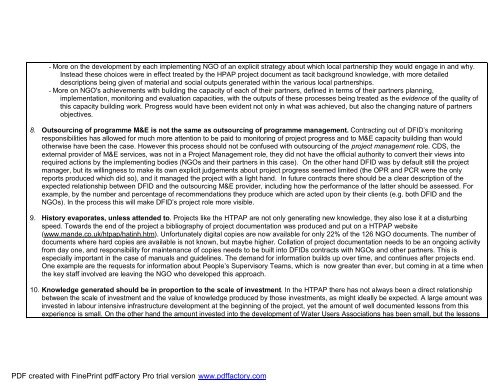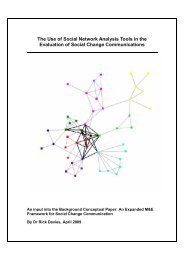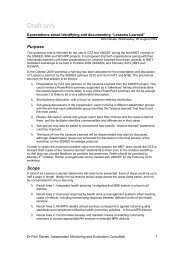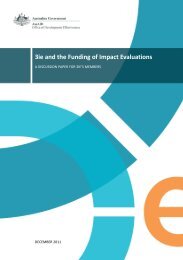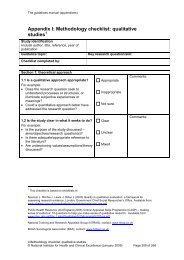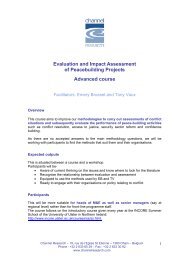DFID 2003 Ha Tinh PCR.pdf - Monitoring and Evaluation NEWS
DFID 2003 Ha Tinh PCR.pdf - Monitoring and Evaluation NEWS
DFID 2003 Ha Tinh PCR.pdf - Monitoring and Evaluation NEWS
You also want an ePaper? Increase the reach of your titles
YUMPU automatically turns print PDFs into web optimized ePapers that Google loves.
- More on the development by each implementing NGO of an explicit strategy about which local partnership they would engage in <strong>and</strong> why.<br />
Instead these choices were in effect treated by the HPAP project document as tacit background knowledge, with more detailed<br />
descriptions being given of material <strong>and</strong> social outputs generated within the various local partnerships.<br />
- More on NGO's achievements with building the capacity of each of their partners, defined in terms of their partners planning,<br />
implementation, monitoring <strong>and</strong> evaluation capacities, with the outputs of these processes being treated as the evidence of the quality of<br />
this capacity building work. Progress would have been evident not only in what was achieved, but also the changing nature of partners<br />
objectives.<br />
8. Outsourcing of programme M&E is not the same as outsourcing of programme management. Contracting out of <strong>DFID</strong>’s monitoring<br />
responsibilities has allowed for much more attention to be paid to monitoring of project progress <strong>and</strong> to M&E capacity building than would<br />
otherwise have been the case. However this process should not be confused with outsourcing of the project management role. CDS, the<br />
external provider of M&E services, was not in a Project Management role, they did not have the official authority to convert their views into<br />
required actions by the implementing bodies (NGOs <strong>and</strong> their partners in this case). On the other h<strong>and</strong> <strong>DFID</strong> was by default still the project<br />
manager, but its willingness to make its own explicit judgements about project progress seemed limited (the OPR <strong>and</strong> <strong>PCR</strong> were the only<br />
reports produced which did so), <strong>and</strong> it managed the project with a light h<strong>and</strong>. In future contracts there should be a clear description of the<br />
expected relationship between <strong>DFID</strong> <strong>and</strong> the outsourcing M&E provider, including how the performance of the latter should be assessed. For<br />
example, by the number <strong>and</strong> percentage of recommendations they produce which are acted upon by their clients (e.g. both <strong>DFID</strong> <strong>and</strong> the<br />
NGOs). In the process this will make <strong>DFID</strong>’s project role more visible.<br />
9. History evaporates, unless attended to. Projects like the HTPAP are not only generating new knowledge, they also lose it at a disturbing<br />
speed. Towards the end of the project a bibliography of project documentation was produced <strong>and</strong> put on a HTPAP website<br />
(www.m<strong>and</strong>e.co.uk/htpap/hatinh.htm). Unfortunately digital copies are now available for only 22% of the 126 NGO documents. The number of<br />
documents where hard copies are available is not known, but maybe higher. Collation of project documentation needs to be an ongoing activity<br />
from day one, <strong>and</strong> responsibility for maintenance of copies needs to be built into <strong>DFID</strong>s contracts with NGOs <strong>and</strong> other partners. This is<br />
especially important in the case of manuals <strong>and</strong> guidelines. The dem<strong>and</strong> for information builds up over time, <strong>and</strong> continues after projects end.<br />
One example are the requests for information about People’s Supervisory Teams, which is now greater than ever, but coming in at a time when<br />
the key staff involved are leaving the NGO who developed this approach.<br />
10. Knowledge generated should be in proportion to the scale of investment. In the HTPAP there has not always been a direct relationship<br />
between the scale of investment <strong>and</strong> the value of knowledge produced by those investments, as might ideally be expected. A large amount was<br />
invested in labour intensive infrastructure development at the beginning of the project, yet the amount of well documented lessons from this<br />
experience is small. On the other h<strong>and</strong> the amount invested into the development of Water Users Associations has been small, but the lessons<br />
PDF created with FinePrint <strong>pdf</strong>Factory Pro trial version www.<strong>pdf</strong>factory.com


